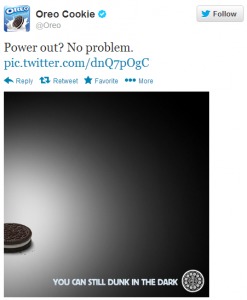 We are hearing a lot lately about “real-time marketing” in social media. The most-cited example is Oreo jumping on the Superdome blackout during this year’s Super Bowl with the “You can still dunk in the dark” Tweet and image:
We are hearing a lot lately about “real-time marketing” in social media. The most-cited example is Oreo jumping on the Superdome blackout during this year’s Super Bowl with the “You can still dunk in the dark” Tweet and image:
“How clever.”
“How timely.”
“How?”
Anyone who manages a brand’s social media efforts was certainly shaking their fists and their heads that they didn’t think of this. But truly, how many brand social media managers were not drowning in a small ocean of malt and hops at the moment this happened? I was on the way home from our own Super Bowl party to make sure my son and his friends had not overindulged in Doritos to the point of needing medical attention (all was clear; I heard the blackout happen on the car radio).
The problem in the aftermath was that “real-time marketing” became a buzzword, a shiny object, a have-to-have. You know what happens next: people try too hard. Brands try to force themselves on live events they have no business horning in on. Example: the Oscars, which had a hard enough time keeping their own broadcast relevance, saw a flood of social media posts trying to hang on to the side of that big ship. Scott Monty chronicled some of those, and the varying reactions, on his own blog post on this topic.
So how do you do this “real-time marketing” thing without falling flat or looking foolish? There are approximately 87 easy steps, a few of which I detail below:
Plan Ahead: This means a few things: first, plot out a calendar and find all predictable events, holidays, and other notable milestones in the year ahead. Pick some that aren’t too much of a stretch, and plan some content ahead. Also, be ready to produce something quickly. Have content – product images, etc. – stored in a way that they can be easily manipulated for those events you can’t plan for (where did the “dunk in the dark” image come from?).
Be Willing to Work Off-Hours Sometimes you can plan: certainly, Oreo was paying attention during the Super Bowl; just as certainly, many other social media ninjas were liver-deep in suds at their local Big Game party. Nobody could have anticipated the blackout, but you can’t do a thing about it if you aren’t in place to move quickly and react. Technology allows us to post from just about anywhere, but having someone on duty increases the odds you may be around for lightning to strike (my Super Bowl party was at a spot with awful cell phone access, so there are limits to the “remote posting” angle).
Have a Flexible Brand Persona -This includes integrating chatter and current events into your social content, along with the type of persona that wouldn’t feel out of place making those comments. If you suddenly said something witty about the Gonzaga Men’s basketball team during the NCAA Basketball Tournament, would it be welcome or would it seem off-key next to your usual content, even if it’s the cleverest thing ever Tweeted? Oreo had been doing fun things with their product image for a while. The only thing surprising about “Dunk in the dark” was that they pulled it off with perfect timing; it looked like a lot of other things they have done (perhaps even less interesting).
Have People in Place You Can Trust: Being clever and funny is a solemn task; if you are lucky to have someone who can pull off a quip or funny idea on a moment’s notice without offending people, without corrupting the brand image and without getting seen as lame, hang onto that person. Comedy is hard; for a meta-example, just see this Tumblr (thanks again to Scott Monty) that tried to compile failed attempts at clever real-time marketing but fails to be funny in its own supposedly biting commentary. Talk about failing to deliver on a promise.
Real-time marketing? Don’t try too hard, but try hard to be ready for the right moment. That’s all; simple, right?
Image credit: wwarby on Flickr

Perfectly stated, mate. Because, yes, not one single brand has been doing anything like smart responses like this before the Super Bowl this year…
It’s like trying to make a viral video or found the next Facebook. You can’t just decide to do it. Sometimes it’s just serendipity. And a flexible management that doesn’t have to pre-approve every message. :) loved this!
I’m not sure about “one single brand” but it’s too easy to say “let’s do what Oreo did” when it’s highly likely they did a lot of this work to make sure they had things in place to be able to do thins on short notice.
It’s not just flexible management, but the confidence to know what leeway you have on the publishing side. I’m guessing in Oreo’s case it has been hard-fought and well-earned.